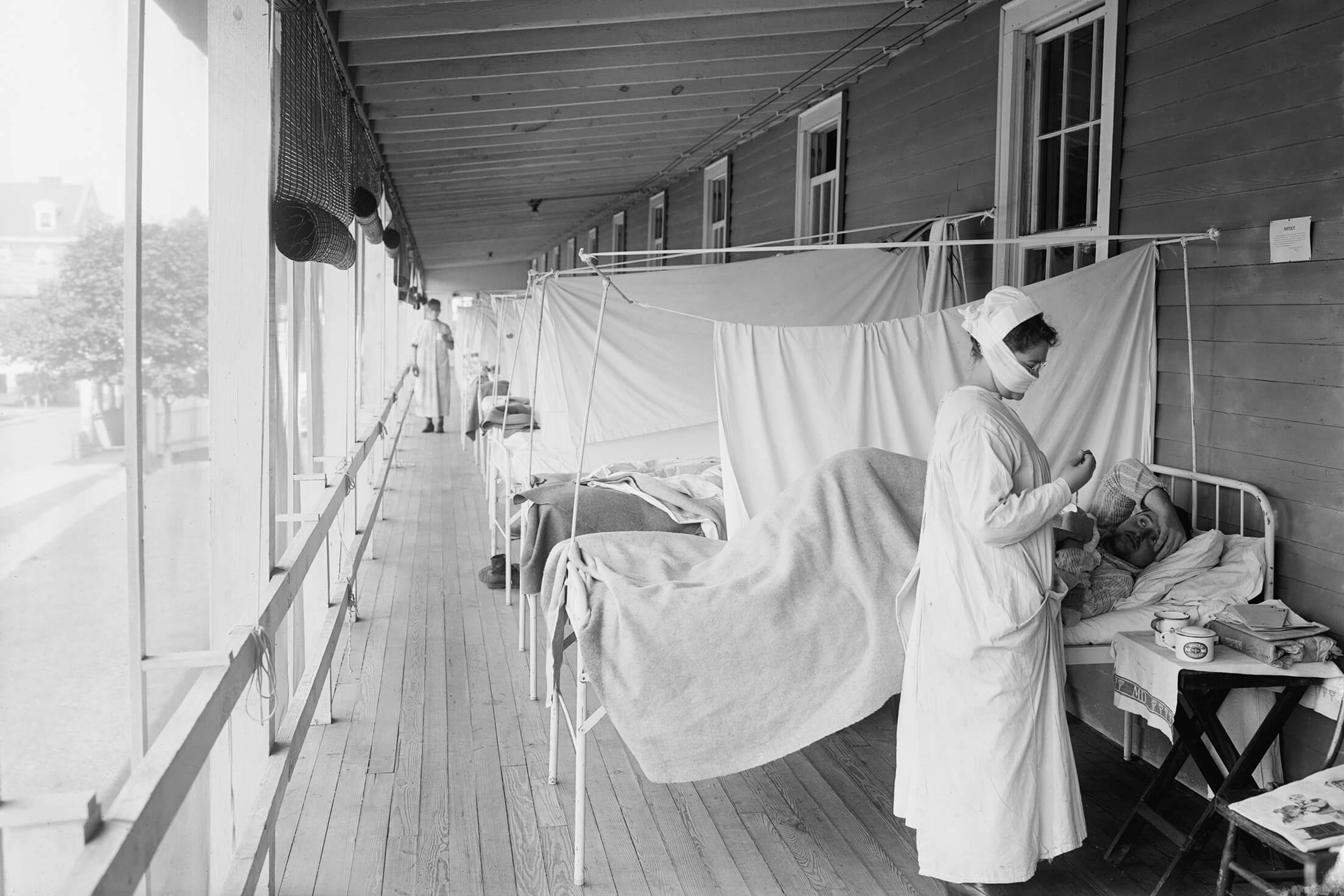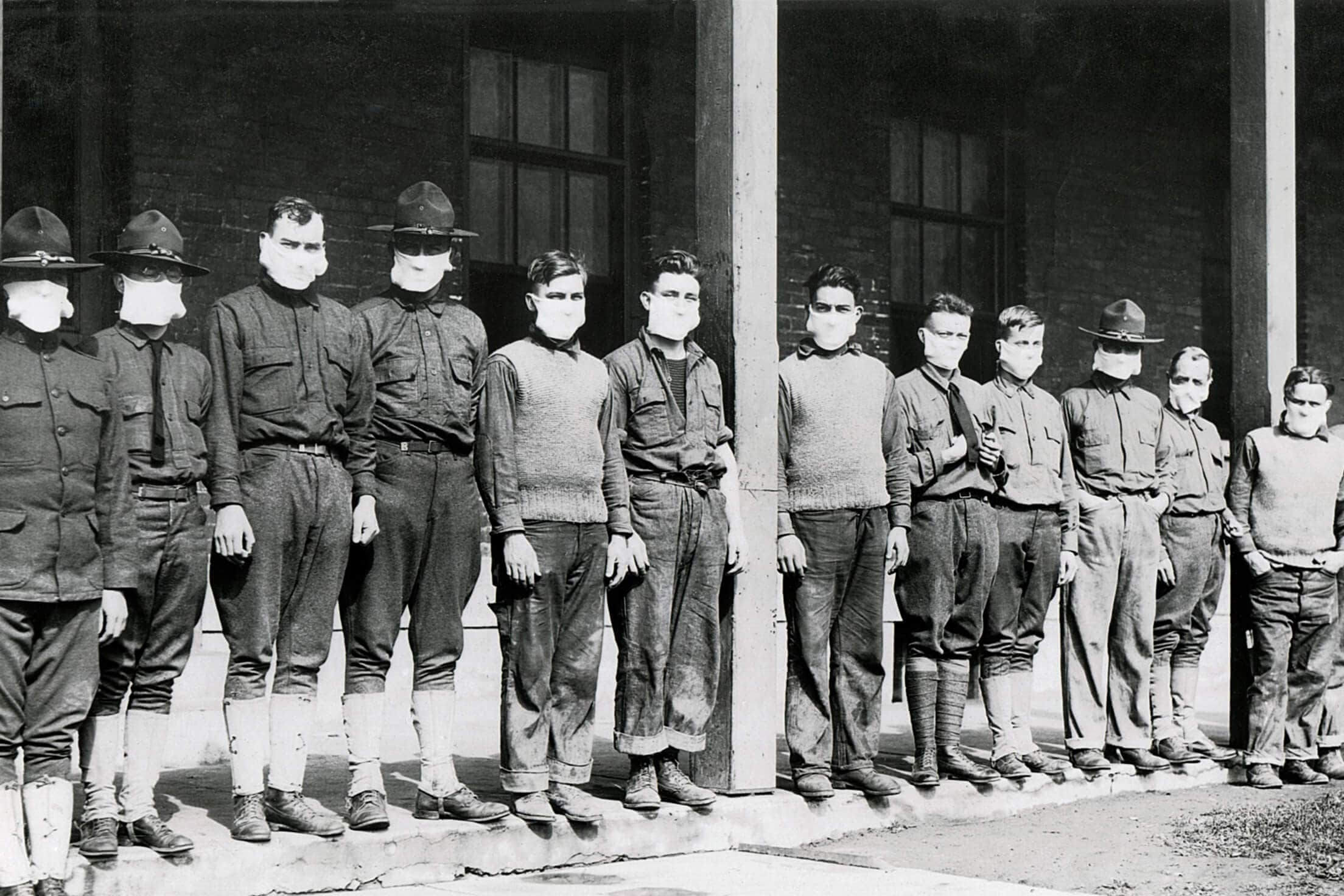Alternate History Spanish Flu Continues Into 1930 s
History of flu (influenza): Outbreaks and vaccine timeline
Learn about flu pandemics, the flu (influenza) vaccine and its impact.

Nurse assisting patient with the flu
A nurse assists a patient at the Walter Reed Hospital flu ward during the flu pandemic of 1918 and 2019.
1918
A flu (influenza) pandemic occurs. The flu pandemic is caused by a new H1N1 flu strain. In New York, people with the flu are required to be isolated at home. In Chicago, movie theaters and theaters close and public gatherings are not allowed. In San Francisco, people who work for the public must wear masks and others are encouraged to wear masks as well. The American Public Health Association suggests that people avoid public transportation. In southeastern Minnesota, near Mayo Clinic, many public spaces such as theaters, churches, meeting places and some schools are closed.
The flu pandemic lasts from 1918 to 1920. From spring of 1918 to spring of 1919, the flu causes more than 550,000 deaths in the U.S. and more than 20 million deaths worldwide.
In the fall of 1918 at Mayo Clinic, people with the flu and other contagious illnesses are cared for in the isolation hospital. Keeping patients with these illnesses isolated and keeping high standards of cleanliness likely prevented infections and saved lives. The isolation hospital of 40 beds is soon filled. The hospital is short of medical staff, and everyone on staff must help where needed. For example, nurses sometimes help in the kitchen and the laundry.
Mayo Clinic's Dr. Edward C. Rosenow invents a flu serum that is made up of a mixed vaccine that includes bacteria that cause pneumonia. Dr. Rosenow gives the serum to Rochester residents for free. While Dr. Rosenow doesn't state that the serum works in protecting against the flu, he notes that the serum doesn't cause harm and might help provide some protection. Mayo Clinic receives many requests for the serum, which is sent to people across Minnesota and the Midwest. In the end, the serum doesn't work as a vaccine to protect against the flu. But it might have helped protect people against pneumonia after having the flu.

Army men wearing masks
Army men stand in a line wearing masks at a U.S. Army hospital during the flu pandemic of 1918 and 1919.
1930s and 1940s
Researchers study flu viruses and develop flu vaccines. At first, mainly military members can get flu vaccines.
1945
The first flu vaccines are approved for use for people who aren't in the U.S. military.
1957-1958
A new H2N2 flu strain causes another flu pandemic. About 116,000 people die in the U.S. and about 1.1. million die worldwide.
1960
In response to the flu pandemic that happened from 1957 to 1958, the U.S. Public Health Service recommends flu vaccines for people in the U.S. who are at high risk of flu complications.
1968
A new H3N2 flu strain causes another flu pandemic. This flu pandemic causes about 100,000 deaths in the U.S. and about 1 million deaths throughout the world. Researchers develop flu vaccines for the specific flu strains causing the pandemic.
1970s
At Fort Dix, a flu outbreak caused by the H1N1 flu strain leads to the development of a flu vaccination program aimed at preventing flu pandemics.
1997
Bird flu (avian influenza) caused by the H5N1 flu strain infects people. This leads to the development of pandemic flu response plans in the U.S. and throughout the world.
2002
ACIP recommends that children ages 6 to 23 months old get an annual flu vaccine.
2007
The FDA approves a flu vaccine for avian influenza A caused by the H5N1 flu strain.
2008
ACIP recommends that people ages 6 months to 18 years old get an annual flu vaccine.
2009
A new H1N1 flu strain causes a flu pandemic. During 2009, the flu causes about 61 million illnesses, 274,0000 hospital stays and 12,400 deaths. Later in 2009, an H1N1 flu vaccine becomes available.
During the H1N1 flu pandemic, Mayo Clinic staff are trained in infection control and prevention. A disaster preparedness team meets regularly to discuss flu planning with clinical areas. Mayo Clinic gives recommendations about H1N1 precautions and provides education about how H1N1 spreads to employees and the community.
2010
ACIP recommends that everyone age 6 months and older get an annual flu vaccine. Gregory Poland, M.D., head of the Vaccine Research Group at Mayo Clinic, introduces and makes this recommendation. Dr. Poland will also recommend that health care providers be required to get vaccinated against the flu in 2016.
2019-2020
Flu vaccines prevent about 7.5 million illnesses, 3.7 million doctor visits, 105,000 hospital stays and 6,300 deaths.
- Plotkin SA, et al., eds. Plotkin's Vaccines. 7th ed. Elsevier; 2018. https://www.clinicalkey.com. Accessed Oct. 8, 2021.
- Blake JB. Benjamin Waterhouse and the introduction of vaccination. Reviews of Infectious Diseases. Oxford University Press. 1987;doi:10.1093/clinids/9.5.1044.
- Desmond A, et al. On the shoulders of giants — From Jenner's cowpox to mRNA Covid vaccines. The New England Journal of Medicine. 2021; doi:10.1056/NEJMp2034334.
- Saleh A, et al. Vaccine development throughout history. Cureus. 2021; doi:10.7759/cureus.16635.
- The history of vaccines. College of Physicians of Philadelphia. https://www.historyofvaccines.org. Accessed Oct. 7, 2021.
- Stokes J, et al. Trivalent combined measles-mumps-rubella vaccine. JAMA. 1971;218:57.
- Klein NP. Licensed pertussis vaccine in the United States: History and current state. 2014; doi:10.4161/hv.29576.
- Influenza historic timeline. Centers for Disease Control and Prevention. https://www.cdc.gov/flu/pandemic-resources/pandemic-timeline-1930-and-beyond.htm. Accessed Oct. 7, 2021.
- Poland GA, et al. Development of vaccines against Zika virus. The Lancet. Infectious Diseases. 2018; doi:10.1016/S1473-3099(18)30063-X.
- Poland GA, et al. Zika vaccine development: Current status. Mayo Clinic Proceedings. 2019; doi:10.1016/j.mayocp.2019.05.016.
- Li YD, et al. Coronavirus vaccine development: From SARS and MERS to COVID-19. Journal of Biomedical Science. 2020; doi:10.1186/s12929-020-00695-2.
- Dolgin E. The tangled history of mRNA vaccines. Nature. 2021; doi:10.1038/d41586-021-02483-w.
- Goodman RA, et al., eds. Vaccination mandates: The public health imperative and individual rights. In: Law in Public Health Practice. Oxford University Press; 2007.
- Centers for Disease Control and Prevention. Current trends childhood immunization initiative, United States — 5-year follow up. MMWR Morbidity and Mortality Weekly Report. 1982; http://www.cdc.gov/mmwr/preview/mmwrhtml/00001091.htm. Accessed Oct. 7, 2021.
- Immunization and infectious diseases. HealthyPeople.gov. https://www.healthypeople.gov/2020/topics-objectives/topic/immunization-and-infectious-diseases. Accessed Oct. 7, 2021.
- The history of vaccines. History of the immunization schedule. College of Physicians of Philadelphia. https://www.historyofvaccines.org/content/history-immunization-schedule. Accessed Oct. 7, 2021.
- NNDS surveillance materials and resources. Centers for Disease Control and Prevention. https://www.cdc.gov/ncird/surveillance/materials-resources.html. Accessed Oct. 7, 2021.
- Roush SW, et al. Historical comparisons of morbidity and mortality for vaccine-preventable disease in the United States. JAMA. 2007;doi:10.1001/jama.
298.18.2155 - Poland GA (expert opinion). Mayo Clinic. Sept. 17, 2021.
- Vaccine effectiveness: How well do flu vaccines work? Centers for Disease Control and Prevention. https://www.cdc.gov/flu/vaccines-work/vaccineeffect.htm. Accessed Oct. 8, 2021.
- 1918 pandemic influenza timeline. Centers for Disease Control and Prevention. https://www.cdc.gov/flu/pandemic-resources/1918-commemoration/pandemic-timeline-1918.htm. Accessed Oct. 8, 2021.
- Safety of COVID-19 vaccines. Centers for Disease Control and Prevention. https://www.cdc.gov/coronavirus/2019-ncov/vaccines/safety/safety-of-vaccines.html. Accessed Oct. 8, 2021.
- Understanding mRNA COVID-19 vaccines. Centers for Disease Control and Prevention. https://www.cdc.gov/coronavirus/2019-ncov/vaccines/different-vaccines/mRNA.html. Accessed Oct. 8, 2021.
- COVID-19 vaccines. U.S. Food and Drug Administration. https://www.fda.gov/emergency-preparedness-and-response/coronavirus-disease-2019-covid-19/covid-19-vaccines. Accessed Oct. 12, 2021.
- Poland GA, et al. The age-old struggle against the antivaccinationists. The New England Journal of Medicine. 2011; doi:10.1056/NEJMp1010594.
- Clapesattle H. The Doctors Mayo. The University of Minnesota Press; 1941.
- Saint Mary's isolation hospital during the influenza pandemic. Saint Marys Hospital Annals; 1918.
- Harren R. Olmsted country in the grippe of Spanish influenza. The Scribe. History Center of Olmsted Country. 2018.
- Strand PK. A Century of Caring: 1889-1989. Saint Marys Hospital; 1988.
- Mayo Clinic: The battle plan for H1N1. Mayo Alumni Magazine; 2009.
- First polio vaccine delivery. MayoVox. Mayo Clinic; 1955.
- Rosenow EC. Prophylactic inoculation against respiratory infections during the present pandemic of influenza: Preliminary report. Mayo Clinic; 1918.
- Rules concerning the report of contagious diseases. The Clinic Bulletin. 1919;1;1.
- Maltezou HA, et al. Immunization of health-care providers: Necessity and public-health policies. Healthcare. 2016; doi: 10.3390/healthcare4030047.
- Voigt EA, et al. Defending against smallpox: A focus on vaccines. Expert Review of Vaccines. 2016; doi:10.1080/14760584.2016.1175305.
- Wright GH, et al. Effect of reduced dose schedules and intramuscular injection of anthrax vaccine adsorbed on immunological response and safety profile: A randomized trial. Vaccine. 2014; doi:10.1016/j.vaccine.2013.10.039.
- Spikevax and Moderna COVID-19 vaccine. U.S. Food and Drug Administration. https://www.fda.gov/emergency-preparedness-and-response/coronavirus-disease-2019-covid-19/spikevax-and-moderna-covid-19-vaccine#additional. Accessed Feb. 11, 2022.
Source: https://www.mayoclinic.org/coronavirus-covid-19/history-disease-outbreaks-vaccine-timeline/flu
0 Response to "Alternate History Spanish Flu Continues Into 1930 s"
Post a Comment